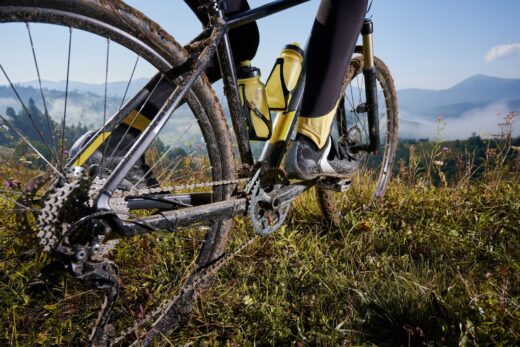Caring for your bike pedals is vital for ensuring a smooth and efficient ride. One often overlooked yet crucial aspect is selecting the right grease. In this guide, we delve deep into the world of bike pedal grease, covering types, applications, and maintenance. Let’s explore how to keep your pedals spinning seamlessly!
Different Types of Bike Pedal Grease
Silicone Grease for Bike Pedals
Silicone-based grease, known for its water resistance, is an excellent choice for mountain bikers and those who brave wet conditions. Its ability to repel water prevents rust and corrosion, enhancing the longevity of your pedals.
Teflon Bike Pedal Grease
Teflon-infused grease offers exceptional lubrication and is highly durable. It reduces friction, ensuring smooth pedal rotations. This type is ideal for riders seeking enhanced performance and reduced wear and tear.
Synthetic Bike Pedal Grease
Synthetic grease is versatile, suitable for various bike types and riding conditions. Its high-temperature stability makes it a go-to for riders who push their pedals to the limit. It’s a reliable option for both casual and competitive cyclists.
Applying Grease to Bike Pedals
Step 1: Clean the Pedals
Before applying grease, ensure your pedals are clean and free from debris. Use a gentle cleaner to remove dirt, grime, and remnants of old grease.
Step 2: Apply the Grease
Using a clean brush or your fingers, apply a thin and even layer of grease to the pedal threads. Avoid over-greasing, as excess grease can attract more dirt and create a messy buildup.
Step 3: Reassemble the Pedals
Once the grease is applied, reattach the pedals to the crank arms. Tighten them securely, ensuring a snug fit without over-tightening.
Importance of Regular Maintenance
Proper maintenance goes beyond initial greasing. Regularly inspect your pedals and reapply grease when necessary. A well-maintained pedal ensures optimal performance, longevity, and a smoother ride.
Grease Comparison Table
Here’s a quick comparison of the three main types of bike pedal grease:
| Grease Type | Water Resistance | Lubrication | Versatility | Longevity |
|---|---|---|---|---|
| Silicone Grease | High | Moderate | Limited | Good |
| Teflon Grease | Low | High | Limited | Excellent |
| Synthetic Grease | Moderate | High | High | Excellent |
Tips for Prolonging Pedal Lifespan
- Regular Cleaning: Wipe down pedals after rides to prevent dirt buildup;
- Storage: Store your bike in a dry place to prevent moisture-related damage;
- Pedal Maintenance Schedule: Set reminders for grease application and routine maintenance;
- Pedal Covers: Consider pedal covers to shield them from harsh weather conditions.
Case Study: Enhanced Performance with the Right Grease
Meet Sarah, an avid mountain biker. She switched to Teflon grease after experiencing pedal resistance. The result? A significant reduction in friction and smoother pedal rotations, enhancing her overall biking experience.

Comparing Grease Brands: Which One to Choose?
When it comes to selecting the best grease for your bike pedals, the brand choice can make a significant difference. Let’s take a closer look at two popular grease brands and compare their offerings:
PedalMaster Grease
Composition: PedalMaster Grease boasts a unique blend of synthetic polymers and Teflon particles. This combination provides exceptional lubrication and temperature resistance.
Advantages:
- High-performance lubrication;
- Long-lasting protection against wear;
- Ideal for competitive cyclists and extreme conditions.
Disadvantages:
- Slightly higher price point;
- Limited availability in some regions.
EcoPedal Grease
Composition: EcoPedal Grease is formulated with biodegradable ingredients, making it an environmentally friendly choice. It incorporates natural oils for smooth lubrication.
Advantages:
- Eco-friendly and biodegradable;
- Suitable for riders concerned about the environment;
- Good general-purpose grease for everyday cycling.
Disadvantages:
- May require more frequent reapplication;
- Slightly lower temperature resistance compared to synthetic options.
Choosing between these brands depends on your priorities—whether you prioritize high performance, longevity, or environmental sustainability.
The Science Behind Grease Selection
Understanding the science behind grease selection can help you make an informed choice. Grease is formulated with a base oil, thickener, and additives. The base oil provides lubrication, while the thickener gives grease its structure. Additives enhance the grease’s properties, such as temperature resistance and load-bearing capacity.
For bike pedals, a grease with a higher viscosity base oil is ideal, as it provides better staying power and reduces the need for frequent reapplication. Look for greases with additives that improve water resistance, temperature stability, and anti-corrosion properties.
Grease Application Tips for Beginners
Applying grease to bike pedals might seem daunting for beginners, but it’s a straightforward process. Here are some additional tips to ensure you get it right:
- Gloves: Wear disposable gloves to prevent grease from getting on your hands and to ensure a clean application;
- Clean Threads: Ensure pedal threads are thoroughly cleaned and dried before applying grease;
- Even Coating: Apply a thin, even layer of grease on the threads to prevent excess buildup;
- Torque Specification: Follow the manufacturer’s recommended torque specification when reattaching pedals to avoid over-tightening;
- Keep Records: Maintain a log of grease applications to track when reapplication is due.
Beyond Pedals: Other Bike Components that Need Grease
While pedals are a crucial component, they aren’t the only parts that benefit from proper lubrication. Here are a few other bike components that require grease:
- Headset Bearings: Grease the headset bearings to ensure smooth steering;
- Bottom Bracket: Apply grease to the bottom bracket threads and bearings to prevent creaking and ensure efficient pedaling;
- Seatpost: Grease the seatpost to prevent seizing and make adjustments easier.
Frequently Asked Questions
Depending on your riding frequency and conditions, aim for every 500-1000 miles or at the start of each season.
It’s best to use grease specifically designed for bike pedals, as they endure unique stresses.
Yes, excess grease can attract dirt and debris, potentially leading to a decrease in performance.
Before applying grease, clean off rust using a rust remover. Greasing over rust can worsen the issue.
Yes, some manufacturers offer eco-friendly and biodegradable grease choices.
Conclusion
Selecting the right grease for your bike pedals is a vital aspect of bike maintenance. Whether you’re a casual rider or a seasoned cyclist, understanding the various grease types, application techniques, and maintenance tips ensures your pedals remain efficient and dependable. Keep your rides smooth and enjoyable by choosing the perfect pedal grease for your needs.






